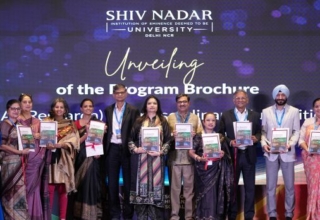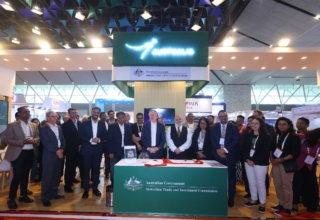
Indian Institute of Technology Madras (IIT Madras) honoured 12 of its alumni in Indian Space Research Organisation (ISRO) who played a pivotal role in the historic Chandrayaan-3 mission.
The top scientists and engineers from ISRO also interacted with students from IIT Madras and various government schools and city colleges during an event titled ‘Over the Moon with Team Chandrayaan-3’ held in the campus on Oct 8.
Those honoured during the occasion include Dr. S. Unnikrishnan Nair who completed his PhD from the Department of Mechanical Engineering, IIT Madras, in 2011 (2011 / PhD / ME) and is the Director of Vikram Sarabhai Space Centre (VSSC), ISRO, and Dr. P. Veeramuthuvel (PhD / ME), Project Director, Chandrayaan-3, ISRO, who completed his PhD in Mechanical Engineering in 2016.
It may also be noted that Shri S Somanath, Chairman, ISRO, is currently pursuing a PhD from the Department of Mechanical Engineering at IIT Madras.
Addressing the gathering, Chief Guest Dr. S. Unnikrishnan Nair, Director, Vikram Sarabhai Space Centre (VSSC), ISRO, said, “This month, we will be having the first big mission of Gaganyaan from Sriharikota. We are going to demonstrate the in-flight system. In manned missions, it is not the mission success but it is the safety of the crew that counts. We are testing and ensuring that the escape system has got a very high reliability…The escape system will be activated in transonic conditions, which is Mach 1.2 and we will demonstrate how the crew will be rescued. We are all looking forward to that mission. There are many exciting missions in the future.”
Dr. S. Unnikrishnan Nair added, “Another interesting mission that we did at Chitradurga Range was a winged aircraft that we call a ‘Reusable Launch Vehicle’. Unlike a conventional satellite, it is a winged body like the space shuttle… The last phase of this experiment, which is dropping from a high kilometre and landing, that too in a totally autonomous way using its intelligence, we could do and landed very close to the central line of the runway. The difference was only 18 cms. That was the type of accuracy we could achieve. And this technology, maybe in another two years’ timeframe, will mark another era of reusable launch vehicles, thereby reducing cost.”
Dr. S. Unnikrishnan Nair said, “In the last one year, India has launched many, many missions. There were failures and we came out of the failures but there were some unique missions too. We thought of using inflatable systems. Can we reduce the speed of an aircraft or a rocket part by inflating a system and reducing its velocity from supersonic conditions to sub-sonic conditions so that we can recover the stage and reduce the cost? That was one experiment we did using a sounding rocket and it was a successful experiment. We are now trying to scale it up, so that in future, we can recover the spent stages that are falling into the sea and re-use by using this technology.”
Recalling his days as a PhD Student at IIT Madras, Dr. S. Unnikrishnan Nair added, “I stayed in this campus for hardly one semester but that one semester made a lot of changes in me. My guru for PhD, Prof. P. Chandramouli is now heading the Department…We feel proud that we belong to this institute and that we could do something that is because of the energy and enthusiasm that we got by being part of great institution.”
Delivering the keynote address and a presentation on Chandrayaan-3, Dr. P. Veeramuthuvel, Project Director, Chandrayaan-3, ISRO, said, “It is by virtue of excellent team work and sheer perseverance that we have achieved this safe and soft landing technology on the lunar surface. It is not only an achievement for the scientific community but it has become the country’s achievement. This time, failure was not an option for us. But success did not come easily also. We crafted the lander in such a way that any path it takes, it should land. That was our strategy this time. All our teams, particularly, across navigation, guidance, control, propulsion systems, sensors and all the components, worked in unison. The confidence stemmed from hundreds of lab tests and three important field tests. That was the most challenging task – creating the lunar environment on earth and proving that all our systems will work before the launch. It was one of our important tasks.”
Further, Dr. P. Veeramuthuvel said, “The Moon is away by 3.84 lakh kms. Reaching the moon itself is a challenging task, even though we have done it in Chandrayaan 1 and 2. We have to do it precisely. All system performances have to be on the dot to reach the moon. Unlike other spacecraft, we have to launch in a specific launch window because the landing is dictated by the launch window. We cannot launch in any given month. We typically have a window which is twice in a year – January-February and July-August. Which means, we have to realize the spacecraft well on time.”
Other ISRO scientists and engineers (IIT Madras Alumni), who were part of the Chandrayaan-3 mission, shared their experiences during the event. They include:
- Dr. P. Arun Kumar (1999/M.Tech/ME), Deputy Director, Earth Storable Engines and Stages(ESES)
- Dr. John Tharakan (1987/M.Tech/ME, 2001/PhD/AMBE), Liquid Propulsion Systems Centre (LPSC)
- Shri Abdul Hameed, (2004/M.Tech/ ME) Scientist/Engineer, U R Rao Satellite Centre (URSC)
- Shri Rajeev Senan C. (2005 / M.Tech / ME), Division Head, Monopropellant Systems & Components Division, LPSC
- Dr. Shamrao (2009/ M.Tech, 2020/PhD / ME), Scientist, URSC
- Shri H.M. Raghavendra Prasad (2012 / M.tech / ME), Scientist/Engineer, Head, Mechanism Assembly Section, Spacecraft Mechanisms Group, URSC
- Dr. S. Mathavaraj, Scientist (2012 / M.Tech / AE), URSC
- Shri R. Karthik (2019 / MS, PhD / EE), Scientist, LPSC
- Shri B.S. Phani Dinakar (2017 / M.Tech / ME), Scientist, URSC
- Shri Sakthivel M. (2017 / M.Tech / ME), Scientist/Engineer, Mechanism and Development Division, Spacecraft Mechanisms Group, URSC
Speaking earlier, Prof. V. Kamakoti, Director, IIT Madras, said, “COVID has taught us that indigenous technology is extremely important to make our country a super power in next 25 years, as we march towards the 100th year of Independence. Very shortly after COVID, here is a great achievement where many inter-disciplinary activities, products and components have gone in. Here are the heroes who say that sky is no longer the limit. We can go much above it.”
Prof. V. Kamakoti, addressing the students present, added, “The days are gone when only Computer Science was deemed important. Please understand that every field of engineering has something great to contribute. This is a very clear message to all our B Techs and our aspiring school students who want to do engineering. Chandrayaan-3 stands as an outstanding example of our times. Take pride and love the subject that you are in. You can see here Mechanical Engineers, Aerospace, Chemical Engineers, and Civil Engineers, all of them put together in one project that has created success.”
IIT Madras believes in sparking scientific curiosity in the minds of the children and youth, to open the windows of their mind to the wonders of STEM learning. This felicitation programme was a step in that direction. Towards this, students from several schools and colleges were invited by the Institute to listen to the ISRO scientists and engineers.
Welcoming the alumni, Prof. Mahesh Panchagnula, Dean (Alumni and Corporate Relations), IIT Madras, said, “IIT Madras is proud to have hundreds of its alumni within ISRO, almost 55,000 alumni globally who are present in over 80 countries excelling in their own fields. But this group of twelve have made us all proud, by doing something that no other country in the world has done. Everyone tried but we succeeded, not just in the mission, but at a cost that is unbelievable for the rest of the world. The cost that we incurred to this mission and to do their science, is a model for rest of the world.”










